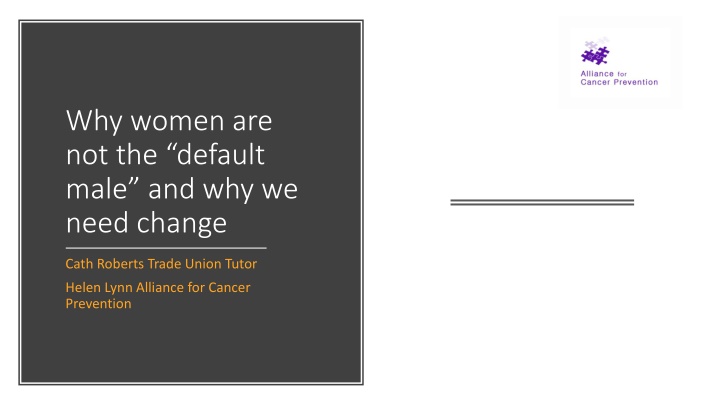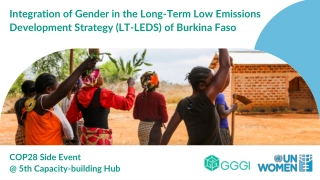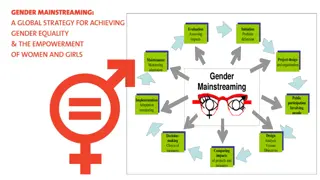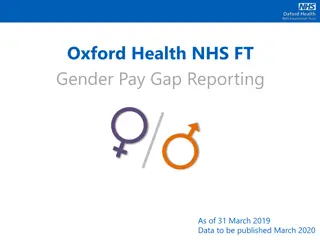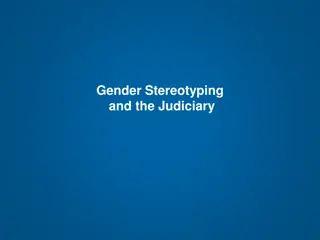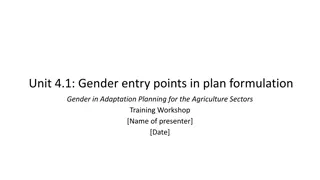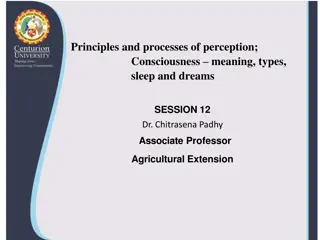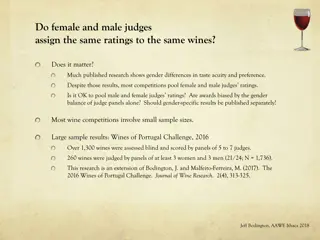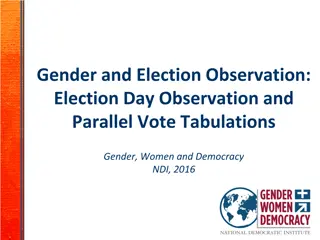Why Women Are Not the Default Male - The Need for Change in Gender Perception
Gender perceptions are explored in-depth, highlighting the difference between sex and gender as socially constructed concepts. The discussion delves into how individuals identify themselves and the implications of aligning gender with biological sex, backed by insights from various sources including the World Health Organization. The challenges faced by women in different professions, such as healthcare, are also addressed, emphasizing the importance of recognizing and addressing sexist practices. This informative content sheds light on societal norms and the necessity for a shift towards inclusive gender perspectives.
Download Presentation

Please find below an Image/Link to download the presentation.
The content on the website is provided AS IS for your information and personal use only. It may not be sold, licensed, or shared on other websites without obtaining consent from the author.If you encounter any issues during the download, it is possible that the publisher has removed the file from their server.
You are allowed to download the files provided on this website for personal or commercial use, subject to the condition that they are used lawfully. All files are the property of their respective owners.
The content on the website is provided AS IS for your information and personal use only. It may not be sold, licensed, or shared on other websites without obtaining consent from the author.
E N D
Presentation Transcript
Why women are not the default male and why we need change Cath Roberts Trade Union Tutor Helen Lynn Alliance for Cancer Prevention
Definitions of Sex and Gender Defines gender as: a social construction relating to behaviours and attributes based on labels of masculinity and femininity; gender identity is a personal, internal perception of oneself and so the gender category someone identifies with may not match the sex they were assigned at birth where an individual may see themselves as a man, a woman, as having no gender, or as having a non-binary gender where people identify as somewhere on a spectrum between man and woman. Sex and gender are not interchangeable terms, the UK government defines sex as: referring to the biological aspects of an individual as determined by their anatomy, which is produced by their chromosomes, hormones and their interactions generally male or female something that is assigned at birth
The World Health Organisation recognises that sex is biologically defined but gender is based on socially constructed or individually defined or on a spectrum, self-perception and expression.
Hazards Sex and Gender workshop quiz 1. What do 77% of women working in the healthcare service think is sexist? a, Uniforms b, PPE c, The names of wards Answer b: https://blogs.bmj.com/bmj/2021/03/09/personal- protective-equipment-is-sexist/
2. What differs by 41% between male and female bodies? a, Hand grip strength b, Size of ears c, Length of arms Answer a) the typical 70 year old man has a greater hand grip strength than the average 25 year old woman (page 146 The Invisible woman).
3. standard? a. b. c. d. Answer all of the above Which workplace items have been made using a male body as Space suits Supply trolleys Safety shoes and gloves Workbenches and work stations
4. Who lifts the most weight per shift? a. b. c. d. e. Miners Cashiers Cleaners Construction workers Carers Answers: b, c, e. Page 114 Invisible Women. Hazards: Face it, we are sickened by inequality at work. Sharan Burrow. Also sewing machine operators lift more than male manual labours. Page 144 Bent out of shape Karen Messing
Why do female bodies react differently to exposure to toxic chemicals? a) Thinner skin b) More fat tissue c) Detox more slowly d) Smaller lung capacity Answer all four 5.
6. women? a) b) c) Answer. 1. hormonal changes during puberty and hereditary along with lifestyle risk factors. They may also suffer from several AI s at once. What percentage of those living with auto immune diseases are 80% 20% 55%
7. How do we know cancer is linked to occupation and the environment? a, Workers in the same industries get the same cancer not common to the general population. b, Animals and children develop cancers despite not smoking or drinking, having their children too late, or diet. c, Identical twins do not develop the same cancers. Correct Answer: all Source: https://www.hazards.org/cancer/index.htm
What percentage of breast cancer are linked to environmental and occupational risk factors ie exposure to toxic chemicals and pesticides in the workplace and in the wider environment? a) 20% b) 60% c) 50% Correct answer: b) The other 40% are linked to hereditary factors and so-called lifestyle risk factors. 8.
9. When does workplace protection need to kick in for a pregnant woman and the developing foetus? a, In the first three months. b, In the first month c, Before pregnancy. Correct answer: 3. Vandenberg LN. Endocrine disrupting chemicals: strategies to protect present and future generations. Expert Rev Endocrinol Metab. 2021 May;16(3):135-146. Men are susceptible to sperm damage.
UNION RESEARCH INTO PPE UNION RESEARCH INTO PPE 2016 research conducted by Prospect and reported in One Size Doesn t Fit All found that manufacturers and suppliers of PPE are still failing to provide inclusive ranges and pricing policies. By failing to apply their purchasing power, employers are allowing this longstanding problem to continue. Bringing a GOSH approach is needed to press for anthropometric (human measurement) standards, and to take account of the diversity of working populations: gender, ethnicity, and age (particularly PPE and menopausal women).
Issues Musculoskeletal disorders RSI Pregnancy Stress Harassment and violence Uniforms, work wear and footwear Reproductive health Skin conditions Gender identity Menopause Domestic Abuse Others
What can we do in our workplaces? What can we do in our workplaces? What can employers do? Identify any campaigns that your Union has been involved in for SGOSH and share with us.
Ways to get SGOHS on the agenda Ways to get SGOHS on the agenda Surveys Workplace Inspections Review Risk Assessments Body Mapping (Hazards DIY) Questionnaires 1:1 Case Work HSW Committees Training
Gender Sensitive Risk Assessments Gender Sensitive Risk Assessments Key issues for gender-sensitive risk assessment Having a positive commitment and taking gender issues seriously Looking at the real working situation Involving all workers, women and men, at all stages Avoiding making prior assumptions about what the hazards are and who is at risk
Action planning Action planning What will you do to Raise Awareness for SGOSH What help will you need What Employer policies are you and your members aware of HSW Committee is it functioning Campaigning around SGOSH issues
Thank your for all your contributions Thank your for all your contributions Resources: Making women visible in health and safety IUF2020. TUC Gender in Occupational Safety and Health Prospect: Gender in Occupational safety and Health Books: Bent out of shape: Karen Messing Invisible Women: Caroline Criado Perez
